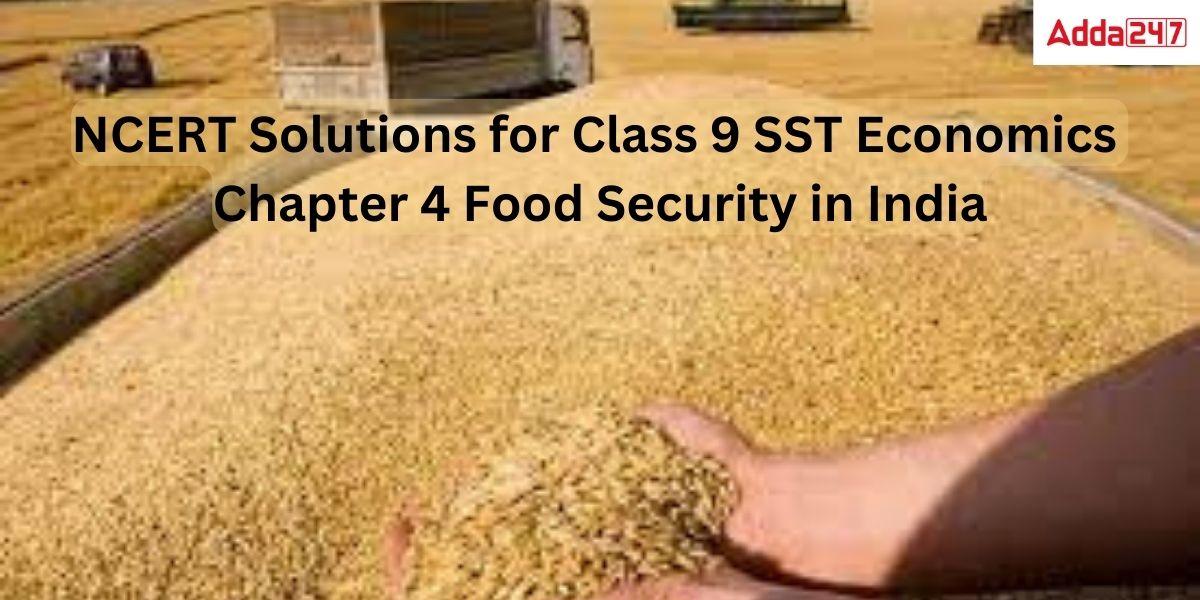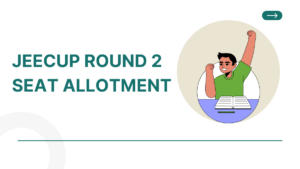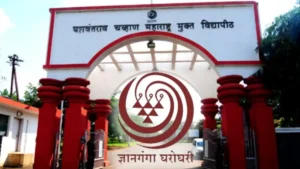NCERT Solutions For Class 9 SST Economics Chapter 4 Food Security in India
NCERT Solutions For Class 9 SST Economics Chapter 4 Food Security in India Notes Are Provided In This Article. NCERT Solutions For Class 9 Is The Finest Resource For Getting A High Class 9 Examination Score. Adda247 Expert Faculty Team Prepared NCERT Solutions For Class 9 SST Economics Chapter 4 Food Security in India Exercises Of That Chapter For A Better Grasp Of The Topics. These NCERT Solutions Answer All Questions In An Easy And Simple Manner. These Solutions Will Help You Understand The Concepts Covered In The Chapter Completely. By Writing These Answers In The Exam Students Will Undoubtedly Be Able To Achieve High Scores. Keep Learning With Adda247.
Read: NCERT Solutions for Class 9 SST Economics Chapter 3 Poverty as a Challenge
NCERT Solutions for Class 9 SST Economics Chapter 4 Food Security in India Pdf
NCERT Solutions for Class 9 SST Economics Chapter 4 Food Security in India Pdf is given in pdf format so students can easily download it for future use. Click here to download NCERT Solutions for Class 9 SST Economics Chapter 4 Food Security in India
Class 9 SST Economics Chapter 4 Food Security in India Video Explanation
Class 9 SST Economics Chapter 4 Food Security in India Summary
Class 9 SST Economics Chapter 3 Poverty as a Challenge introduces food security in India. In this chapter, students will learn about India’s food distribution system and the many government incentives used to guarantee that all of the country’s citizens have access to sufficient quantities of nutritious meals. Let’s take a tour of the topics covered in this chapter before reading the NCERT Solutions for Class 9 SST Economics Chapter 4 Food Security in India.
1. What is Food Security?
2. Why is Food Security needed?
3. Who are food insecure?
4. Green Revolution in India
5. Food Security in India
- Buffer Stock
- Public Distribution System
- Minimum Support Price
- Fair Price Shops
6. The National Food Security Act, 2013
NCERT Solutions for Class 9 SST Economics Chapter 4 Food Security in India Questions with Answers
1. How is food security ensured in India?
Answer: A country’s food security is ensured if there are enough nutrient-rich foods available for all of its residents. Three criteria are used to guarantee food security in a nation. Making sure there is adequate food for everyone is the first step. The ability and resources to get sufficient food are shared by all people, which is the second point. Last but not least, there shouldn’t be any barriers to getting food. The food security system in India was carefully planned and consists of two parts: a buffer stock and a public distribution system.
2. Which are the people more prone to food insecurity?
Answer: People who are below the poverty line may be food insecure all the time, whereas people who are more affluent may become so owing to tragedy or misfortune. Some segments of our society that live in landless or resource-poor homes in rural areas, as well as individuals working in low-paying jobs and seasonal casual workers in metropolitan areas, are the most severely impacted by food insecurity.
3. Which states are more food insecure in India?
Answer: The majority of the country’s food-insecure people live in the Eastern and south-eastern parts of Uttar Pradesh, Bihar, Jharkhand, Orissa, West Bengal, Chattisgarh, and portions of Madhya Pradesh, and Maharashtra.
4. Do you believe that green revolution has made India self-sufficient in food grains? How?
Answer: Following its independence, India changed its agricultural technique, leading to the “Green Revolution,” which had a particular impact on the production of rice and wheat. In July 1968, Indira Gandhi, the country’s prime minister at the time, issued a special stamp titled “Wheat Revolution” to commemorate the remarkable agricultural advancements made possible by the Green revolution. Despite unfavorable weather, India has escaped hunger and a variety of crops are grown throughout the nation. It was made possible for the government to create a proper food security system by the >country’s access to food grains even under difficult circumstances. As a result, it can be considered that India is now self-sufficient in food grains due to the green revolution.
5. A section of people in India are still without food. Explain?
Answer:5.Despite a significant increase in the production of food grains in India, a segment of the population still lacks access to food. Due to the seasonal nature of agricultural employment, they are unemployed for a few months. They work seasonally and are compensated with extremely low earnings that barely cover basic needs. They are unable to purchase food. Chronic hunger affects more than one-fifth of the population of the nation.
6. What happens to the supply of food when there is a disaster or calamity?
Answer: The production and cultivation of food grains are greatly impacted by a national disaster or tragedy such as an earthquake, drought, flood, or tsunami. When production falls, there is a shortage of food grains, which leads to higher food grain prices. Even those who are not categorized as poor may struggle with food insecurity. The ability of many people to purchase food items is impacted by the increased price of those resources. In the event that a catastrophe affects a large area over an extended length of time or both, starvation may result.
7. Differentiate between seasonal hunger and chronic hunger?
Answer: One of the most crucial indicators of food security is hunger. Seasonal hunger is influenced by cycles of food production and harvesting, whereas chronic hunger results from consistently insufficient diets in either amount or quality.
People in rural areas experience seasonal hunger due to the seasonality of agricultural activity, whereas people in urban areas experience chronic hunger due to low income and the inability to purchase even food for basic survival.
Chronically insufficient diets in terms of quantity and/or quality are the cause of chronic hunger. Because of their extremely low incomes and consequent inability to purchase even food for survival, the poor experience chronic hunger.
8. What has our government done to provide food security to the poor? Discuss any two schemes launched by the government?
Answer: Two programmes were started in 2000 with the goal of assisting the underprivileged and ensuring their access to food security. They were the Antyodaya Anna Yojana (AAY) and the Annapurna Scheme (APS),
Antyodaya Anna Yojana (AAY): In India, the Antyodaya Anna Yojana (AAY) public distribution system was introduced in 2000. The system’s primary goal is to eliminate hunger in India and ensure food security for the populace. Each qualified family received 25 kg of food grains under this Yojana at a heavily discounted rate of Rs. 2 per kg of wheat and Rs. 3 per kg of rice.
Annapurna Scheme (APS): Annapurna Scheme was introduced on April 1st, 2000. It aims to provide food security to satisfy the needs of elderly people who are qualified but have not received benefits from the National Old Age Pension Scheme (NOAPS).
9. Why buffer stock is created by the government?
Answer: The Indian government created a food security system, which is made up of two parts: (a) buffer stock and (b) public distribution system, to ensure that food is available to all societal segments. The government establishes a buffer stock of food grains in order to distribute the purchased food grains at a price below market value to the poorer sections of society and to places with a food shortage. Therefore, keeping buffer stock is a measure the government takes to guarantee food security.
10. Write notes on Minimum Support Price, Buffer Stock, Issue Price, and Fair Price Shops
Answer:
Minimum Support Price: In states where there is an excess of production, the Food Corporation of India buys wheat and rice from the farmers. For their crops, the farmers receive payment at a predetermined price. Minimum Support Pricing is the name given to this price. Every year, before the planting season, the government announces the MSP to give farmers incentives to increase the production of these crops.
Buffer Stock: Buffer Stock is the supply of wheat and rice that the government has purchased through the Food Corporation of India (FCI). The government uses this buffer stock to help the less privileged members of society or in the event of a natural disaster.
Issue Price: The government offers grains from the buffer stock to the poorer classes of the population at a price that is far less than the market rate in order to assist them. The Issue Pricing is the subsidized price.
Fair Price Shop: The FCI buys food, which is then given to the less privileged members of society through ration stores under government control. The term “Fair Price Shop” refers to a store that has been granted a license to sell necessary commodities to holders of ration cards under the Targeted Public Distribution System pursuant to an order issued under section 3 of the Essential Commodities Act, 1955. Nowadays, ration shops may be found in the majority of towns, villages, and cities. In the entire nation, there are around 4.6 lakh ration stores. Food grains, sugar, and cooking oil are kept in stock at ration shops, sometimes referred to as Fair Price Shops. People can buy these products for less money.
11. What are the problems with the functioning of ration shops?
Answer: Some problems with the functioning of ration shops are
- The ration shop dealings engage in fraud and deprive the impoverished of the full amount they are allocated.
- The ration is sold more expensively on the open market by ration shop owners.
- Poor people receive food that is of lower quality than what is typically given the number of food grains used.
- Due to not entitle to the Ration List, Most of the poor individuals are fail to get ration from these shops.
12. Write a note on the role of cooperatives in providing food and related items.
Answer. In addition to the government, cooperatives play a significant role in ensuring food security in India, particularly in the south and west of the country. The cooperative organizations have opened stores to provide affordable goods to the underprivileged. For instance, around 94 percent of the fair price stores operating in Tamil Nadu are managed by cooperatives. Amul is a cooperative that sells milk and milk-related products and is in charge of bringing about India’s “White Revolution.”









 DTE Maharashtra Polytechnic Merit List 2...
DTE Maharashtra Polytechnic Merit List 2...
 JEECUP Round 2 Seat Allotment Result 202...
JEECUP Round 2 Seat Allotment Result 202...
 YCMOU Result 2025 Out @ycmou.digitaluniv...
YCMOU Result 2025 Out @ycmou.digitaluniv...









